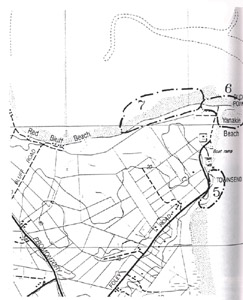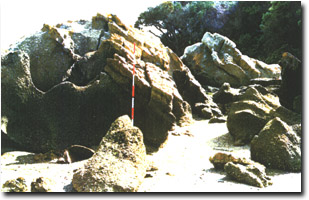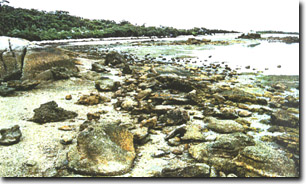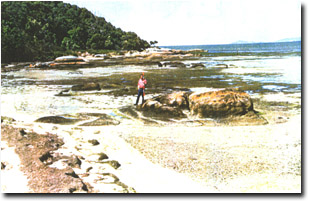5. Townsends Point
This information has been developed from the publication:
|
| Location | 030365. Rocky coast immediately south of Yanakie Beach, Yanakie |
Access: | Foley Road to Yanakie Beach. |
Significant Features: | Townsends Point is a low rocky headland at the base of which are outcrops of pegmatite granite with occasional xenoliths. The granite is overlain by strongly cemented siliceous grits and sand of the Haunted Hills Formation. The rocky sector is the base of a scrub-covered coastal bluff which turns inland behind the camping area and Duck Point. The granite is exposed only at sea level. The low coastal cliff and upper sections of the bluff are in the cemented grit. Small overhangs and caves (possibly emerged marine features) occur in weathered pockets of sediment in the scrub-covered bluff. Apart from one exposure about 2 m above high water mark the contact between the sediments and the granite is generally obscured by a terrace of Melaleuca peat or by this coastal scrub. The granite is intruded by a number of dykes, the largest being 15 cm thick. |
The granite is deeply weathered and has been planed down to a shore platform now partly sand and mud covered. Several low “old hat” type stacks occur on the platform. | |
Significance Level: | Local. The site is one of the few hard rock coasts on the western shore of Corner Inlet and one of only two coastal outcrops of Wilson Promontory granites outside the National Park. It shows the influence of the Haunted Hill Formation on coastal morphology and is an unusual example of platform development in granites. |
Management Issues: | The site is robust and the significant features are not immediately threatened unless there is an extension of the camping area to the south. Small borrow pits near Foley Road are possible erosion sites that may need to be better managed to avoid gully development and downwash onto the cost. The scrub-covered bluff discourages visitor movement and as this may have wildlife values, it is best left undisturbed. |
Research & Monitoring Requirements: | The contact between the granite and sediments and possible emerged marine features need to be examined in more detail. |
Public Interpretation Possibilities: | Explanation of granite features and its relationship to the rocks of Wilson Promontory. |
Main References: | None |
 Sites 5 (Townsends Point), 6 (Duck Point) & 7 (Duck Point West) |  Aplite dyke intruding granite at Townsends Point |
 Weathered granite and gravel at Townsends Point |  "Old Hat" platform in granite at Townsends Point |


